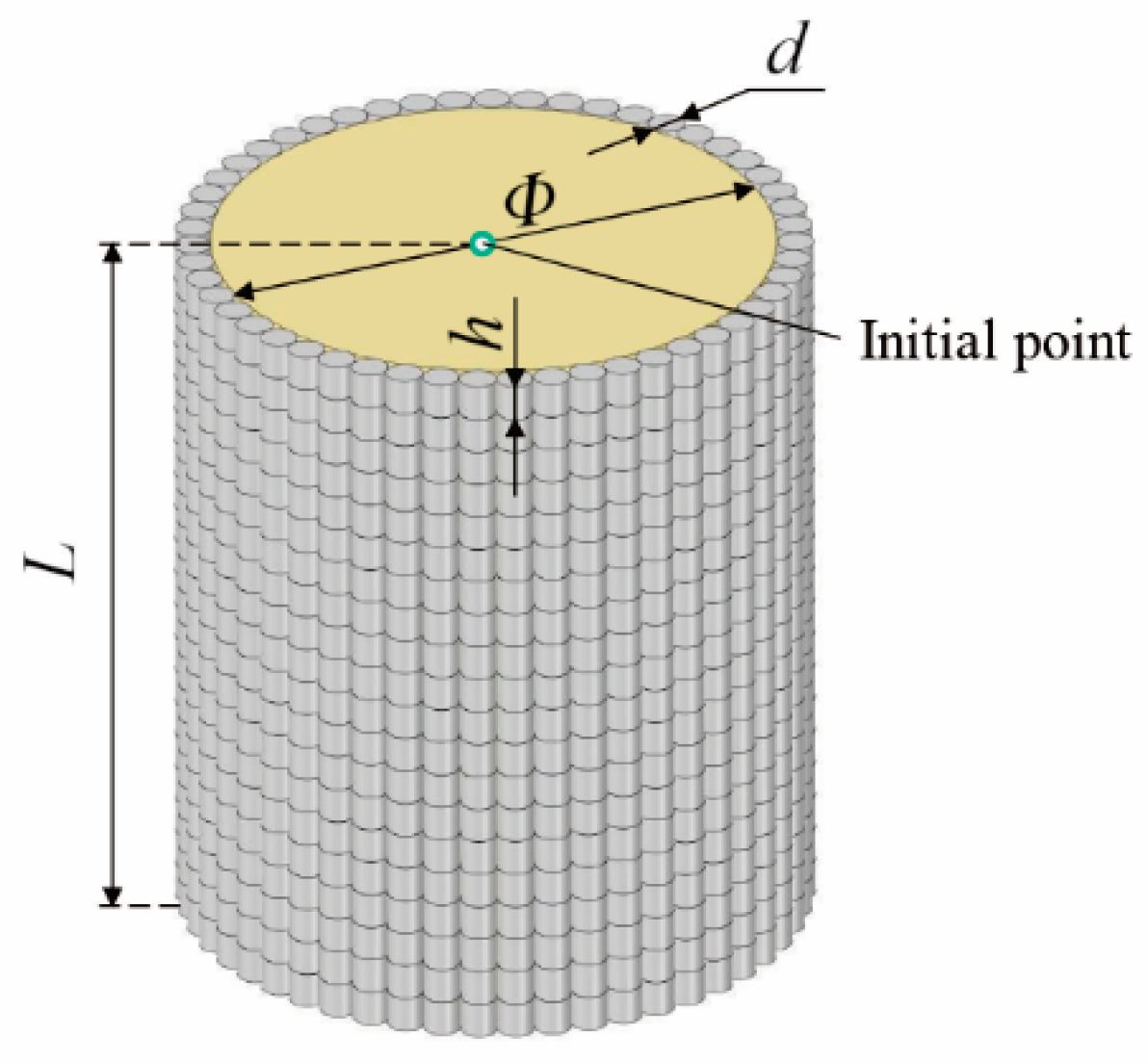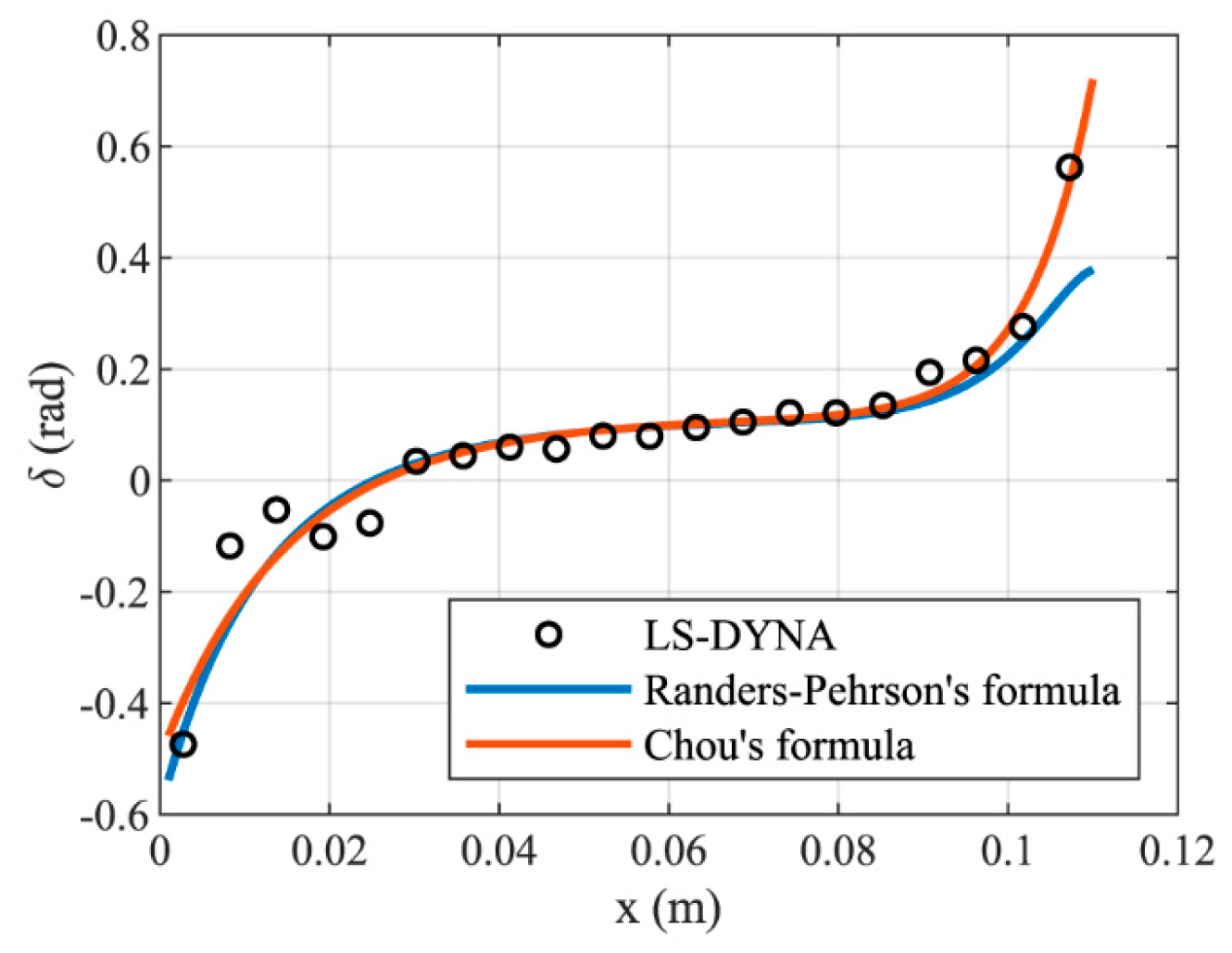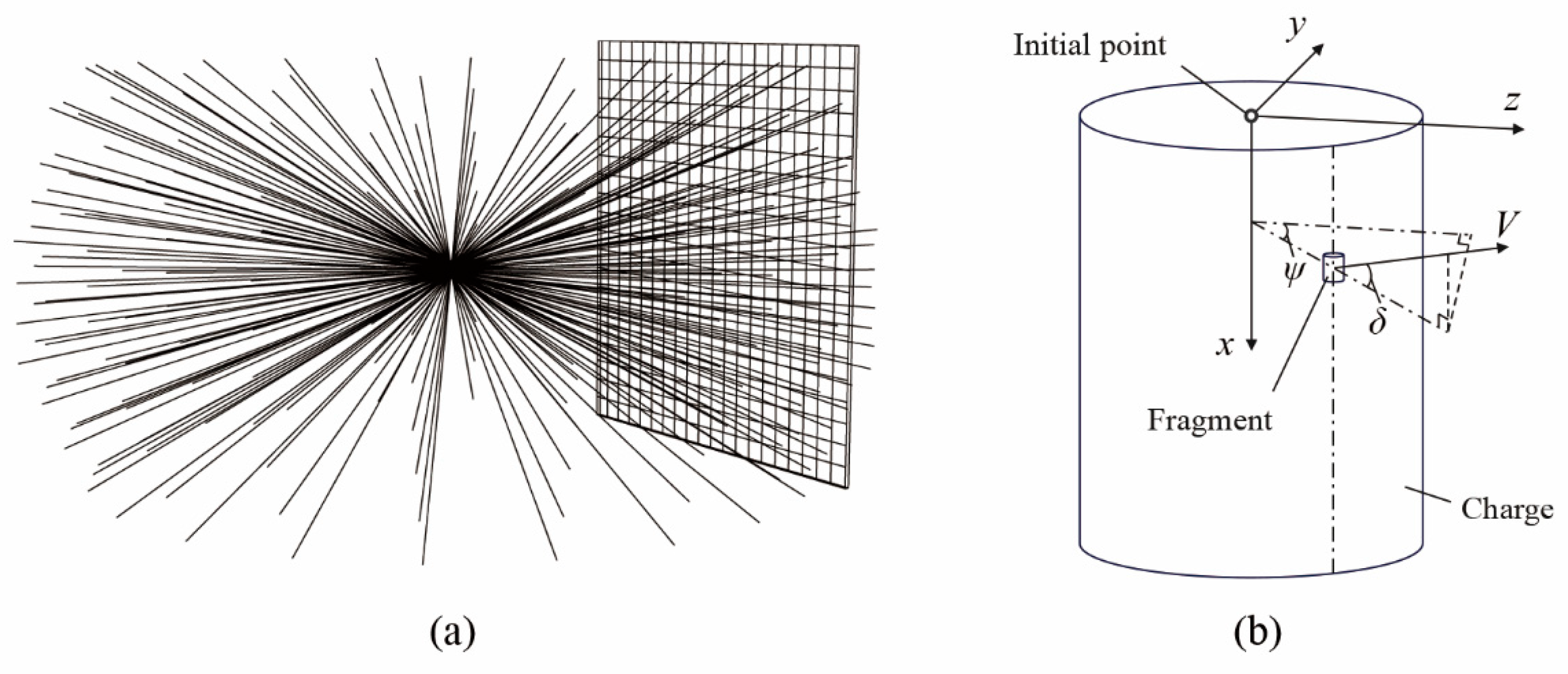Functional Damage Assessment Method for Preformed Fragment Warheads to Evaluate the Effect on the Phased-Array Antenna
Abstract
:1. Introduction
2. Damage Field of the Preformed Fragment LYPGW
2.1. Semi-Empirical Formula Calculation
2.1.1. Calculation of Fragment Velocity
2.1.2. Calculation of Fragment Projection Angle
2.2. Numerical Simulation
2.3. Parameter Identification
3. Damage Mechanism of the Phased-Array Antenna
3.1. Mathematical Model of the Antenna Pattern
3.2. Performance Index of the Phased-Array Antenna
4. Evaluation of Damage Effect
4.1. Projectile Intersection Model Based on the Shot Line
4.2. Analysis and Discussion of Examples
5. Conclusions
Author Contributions
Funding
Institutional Review Board Statement
Informed Consent Statement
Data Availability Statement
Conflicts of Interest
References
- Mets, D.R. The Long Search for a Surgical Strike: Precision Munitions and the Revolution in Military Affairs; CADRE Paper; Air University Press: Montgomery, Alabama, 2001. [Google Scholar]
- Gillespie, P.G. Weapons of Choice: The Development of Precision Guided Munitions; University of Alabama Press: Tuscaloosa, Alabama, 2006; ISBN 978-0-8173-1532-0. [Google Scholar]
- Liu, F.; Shi, Q.; Wang, G.; Zhang, B. Simulation on the Planar Array Antenna Penetrated to Tungsten Spherical Fragment. Adv. Mater. Res. 2013, 753–755, 1060–1064. [Google Scholar] [CrossRef]
- Lv, Y.; Shi, Q.; Wang, G.; Liu, F.; Xu, Y.; Li, G.; Zou, X. Dynamic Finite-Element Simulation on the Phased Array Radar Antenna Multiplex Damage by Fragment and Shock Wave. In Proceedings of the 2012 International Conference on Quality, Reliability, Risk, Maintenance, and Safety Engineering (icqr2mse), Chengdu, China, 15–18 June 2012; Huang, H.Z., Zuo, M.J., Liu, Y., Eds.; IEEE: New York, NY, USA, 2012; pp. 929–933. [Google Scholar]
- Li, X.; Xiang, X.; Huang, G.; Feng, S. Penetration Characteristics of Tungsten Sphere Fragment to Typical Components of Phased Array Radar. Acta Armamentarii 2010, 31, 51–56. [Google Scholar]
- Gurney, R.W. The Initial Velocities of Fragments from Bombs, Shells and Grenades; BRL Report; Ballistic Research Laboratories: Aberdeen, MD, USA, 1943. [Google Scholar]
- Taylor, G.I. Analysis of the Explosion of a Long Cylindrical Bomb Detonated at One End. In The Scientific Papers of Sir Geoffrey Ingram Taylor; Cambridge University Press: Cambridge, UK, 1941; Volume 3, pp. 277–286. [Google Scholar]
- Randers-Pehrson, G. An Improved Equation for Calculating Fragment Projection Angle. In Proceedings of the 2nd International Symposium on Ballistics, Datona Beach, FL, USA,, 9–11 March 1976; International Ballistic Society. American Defense Preparedness Association: Arlington, VA, USA, 1976; pp. 223–226. [Google Scholar]
- Charron, Y.J. Estimation of Velocity Distribution of Fragmenting Warheads Using a Modified Gurney Method; Air Force Institute of Technology Wright-Patterson AFB OH School of Engineering: Dayton, OH, USA, 1979. [Google Scholar]
- Zulkoski, T. Development of Optimum Theoretical Warhead Design Criteria; Naval Weapons Center China Lake: Kern County, CA, USA, 1976. [Google Scholar]
- Chou, P.C.; Carleone, J.; Flis, W.J.; Ciccarelli, R.D.; Hirsch, E. Improved Formulas for Velocity, Acceleration, and Projection Angle of Explosively Driven Liners: Velocity, Acceleration, and Projection Angle of Liners. Propellants Explos. Pyrotech. 1983, 8, 175–183. [Google Scholar] [CrossRef]
- Huang, G.; Li, W.; Feng, S. Axial Distribution of Fragment Velocities from Cylindrical Casing under Explosive Loading. Int. J. Impact Eng. 2015, 76, 20–27. [Google Scholar] [CrossRef]
- Felix, D.; Colwill, I.; Harris, P. Real-Time Calculation of the Initial Angle of Projection for Fragments in Cylindrical Warheads. J. Def. Model. Simul. 2021, 19, 154851292098267. [Google Scholar] [CrossRef]
- Jiang, N.; Li, W.; Yao, W.; Gao, D. Calculation Model of the Axial Dispersion Distribution of Cylindrical-Warhead Fragments. Shock. Vib. 2022, 2022, 3144545. [Google Scholar] [CrossRef]
- Grisaro, H.; Dancygier, A.N. Numerical Study of Velocity Distribution of Fragments Caused by Explosion of a Cylindrical Cased Charge. Int. J. Impact Eng. 2015, 86, 1–12. [Google Scholar] [CrossRef]
- Zhu, S.; Cai, J.; Han, C.; An, T.; Qu, L. Influence of Failed Element on Array Antenna Performance. Electron. Opt. Control. 2019, 26, 54–59. [Google Scholar]
- Zhang, H.; Dong, S.; Bo, L. Damage Analysis of Planar Phased Array Antenna. Radar Sci. Technol. 2017, 15, 322–326+333. [Google Scholar]
- Xiong, S.; Lyu, X.; Duan, J. Damage Analysis of Shipborne Phased Array Radar Antenna. Missiles Space Veh. 2020, 5, 92–98. [Google Scholar]
- Liu, Y.; Zhou, L.; Wang, N. Assessment of Combined Damage to the Phased Array Antenna by Shock Wave and Fragments. Prot. Eng. 2021, 43, 35–40. [Google Scholar]
- Keizer, W.P.M.N. Element Failure Correction for a Large Monopulse Phased Array Antenna with Active Amplitude Weighting. IEEE Trans. Antennas Propagat. 2007, 55, 2211–2218. [Google Scholar] [CrossRef]
- Poli, L.; Rocca, P.; Oliveri, G.; Massa, A. Failure Correction in Time-modulated Linear Arrays. IET Radar Sonar Navig. 2014, 8, 195–201. [Google Scholar] [CrossRef]
- Muralidharan, R.; Vallavaraj, A.; Mahanti, G.K.; Patidar, H. QPSO for Failure Correction of Linear Array of Mutually Coupled Parallel Dipole Antennas with Desired Side Lobe Level and Return Loss. J. King Saud Univ. -Eng. Sci. 2017, 29, 112–117. [Google Scholar] [CrossRef]
- Patidar, H.; Mahanti, G.K.; Muralidharan, R.; Singh, P.K. Failure Correction of a Linear Array of Coupled Parallel Vertical Dipole Antennas. J. Telecommun. Inf. Technol. 2020, 1, 62–69. [Google Scholar] [CrossRef]
- Kong, X.; Wu, W.; Li, J.; Liu, F.; Chen, P.; Li, Y. A Numerical Investigation on Explosive Fragmentation of Metal Casing Using Smoothed Particle Hydrodynamic Method. Mater. Des. 2013, 51, 729–741. [Google Scholar] [CrossRef]
- Wang, L.; Han, F.; Zhou, Q. The Projection Angles of Fragments from a Cylindrical Casing Filled with Charge Initiated at One End. Int. J. Impact Eng. 2017, 103, 138–148. [Google Scholar] [CrossRef]
- Hao, L.; Gu, W.; Zhang, Y.; Yuan, Q.; Xie, X.; Zou, S.; Wang, Z.; Lu, M. Damage of a Large-Scale Reinforced Concrete Wall Caused by an Explosively Formed Projectile (EFP). Def. Technol. 2022. [Google Scholar] [CrossRef]
- Hu, F.; Wu, H.; Fang, Q.; Liu, J. Numerical Simulations of Shaped Charge Jet Penetration into Concrete-like Targets. Int. J. Prot. Struct. 2017, 8, 237–259. [Google Scholar] [CrossRef]
- Boslashrvik, T.; Dey, S.; Clausen, A.H. Perforation Resistance of Five Different High-Strength Steel Plates Subjected to Small-Arms Projectiles. Int. J. Impact Eng. 2009, 36, 948–964. [Google Scholar]
- Keshavarz, M.H. New Method for Prediction of the Gurney Energy of High Explosives. Propellants Explos. Pyrotech. 2008, 33, 316–320. [Google Scholar] [CrossRef]
- Mahafza, B.; Elsherbeni, A. MATLAB Simulations for Radar Systems Design; CRC Press: Boca Raton, FL, USA, 2004; p. 682. ISBN 978-1-58488-392-0. [Google Scholar]
- Mottaghi-Kashtiban, M.; Shayesteh, M.G. New Efficient Window Function, Replacement for the Hamming Window. IET Signal Process. 2011, 5, 499. [Google Scholar] [CrossRef]
- Ramsdale, D.J.; Howerton, R.A. Effect of Element Failure and Random Errors in Amplitude and Phase on the Sidelobe Level Attainable with a Linear Array. J. Acoust. Soc. Am. 1980, 68, 901–906. [Google Scholar] [CrossRef]
- Qian, L.; Liu, T.; Zhang, S.; Yang, Y. Fragment Shot-Line Model for Air-Defence Warhead. Propellants Explos. Pyrotech 2000, 25, 92–98. [Google Scholar] [CrossRef]
- Chen, X.; Zhu, X.; Zhang, L.; Wang, X. Design and Properties of Sandwich Structure for Ballistic-Resistant Radome. Acta Armamentarii 2010, 32, 1298–1302. [Google Scholar]










| Charge Diameter Φ (mm) | Charge Length L (mm) | Fragment Diameter d (mm) | Fragment Length h (mm) |
|---|---|---|---|
| 85 | 110 | 0.4 | 0.4 |
| ρ (kg/m3) | C0–C3 (Pa) | C4 (Pa) | C5 (Pa) | C6 (Pa) | E0 (Pa) | V0 |
|---|---|---|---|---|---|---|
| 1.225 | 0 | 0.4 | 0.4 | 0 | 2.5 × 105 | 1 |
| ρ (kg/m3) | D (m/s) | PCJ (GPa) | A (GPa) | B (GPa) | R1 | R2 | ω | E0 (GPa) | V0 |
|---|---|---|---|---|---|---|---|---|---|
| 1710 | 7890 | 28.6 | 524.2 | 7.768 | 4.2 | 1.1 | 0.34 | 8.5 | 1 |
| ρ (kg/m3) | E (GPa) | ν |
|---|---|---|
| 7850 | 210 | 0.33 |
| Case | Explosion Distance (m) | Number of Failed Elements | Maximum Radar Range Decay Rate (%) |
|---|---|---|---|
| 0 | - | 0 | 0 |
| 1 | 1 | 195 | 9.29 |
| 2 | 3 | 117 | 5.54 |
| 3 | 5 | 96 | 4.53 |
| 4 | 7 | 69 | 3.25 |
| Case | Explosion Distance (m) | Mainlobe Gain (dB) | FSLL in u- Direction (dB) | FSLL in v- Direction (dB) | HPBW in u- Direction (°) | HPBW in v- Direction (°) |
|---|---|---|---|---|---|---|
| 0 | - | 32.04 | −13.27 | −13.27 | 3.52 | 3.52 |
| 1 | 1 | 31.48 | −11.77 | −9.43 | 3.52 | 3.52 |
| 2 | 3 | 31.71 | −13.05 | −11.82 | 3.52 | 3.52 |
| 3 | 5 | 31.77 | −13.20 | −12.33 | 3.52 | 3.52 |
| 4 | 7 | 31.85 | −13.31 | −12.98 | 3.52 | 3.52 |
| Case | Explosion Distance (m) | Mainlobe Gain (dB) | FSLL in u- Direction (dB) | FSLL in v- Direction (dB) | HPBW in u- Direction (°) | HPBW in v- Direction (°) |
|---|---|---|---|---|---|---|
| 0 | - | 29.19 | −42.00 | −42.00 | 5.63 | 5.63 |
| 1 | 1 | 28.59 | −19.75 | −14.45 | 4.92 | 4.92 |
| 2 | 3 | 28.76 | −18.73 | −26.92 | 5.63 | 5.63 |
| 3 | 5 | 28.89 | −22.37 | −31.77 | 5.63 | 5.63 |
| 4 | 7 | 28.99 | −25.66 | −34.02 | 5.63 | 5.63 |
| Case | Failure Elements Distribution Position | Mainlobe Gain (dB) | FSLL in u- Direction (dB) | FSLL in v- Direction (dB) | HPBW in u- Direction (°) | HPBW in v- Direction (°) |
|---|---|---|---|---|---|---|
| 5 | Center | 30.49 | −6.50 | −8.04 | 2.81 | 2.81 |
| 6 | marginal center | 30.49 | −11.72 | −8.04 | 4.22 | 2.81 |
| 7 | uniform edge | 30.49 | −13.23 | −13.27 | 5.63 | 3.52 |
| 8 | edge ends | 30.49 | −14.54 | −14.64 | 4.92 | 4.22 |
| Case | Failure Elements Distribution Position | Mainlobe Gain (dB) | FSLL in u- Direction (dB) | FSLL in v- Direction (dB) | HPBW in u- Direction (°) | HPBW in v- Direction (°) |
|---|---|---|---|---|---|---|
| 5 | center | 28.26 | −7.23 | −13.55 | 3.52 | 4.22 |
| 6 | marginal center | 27.10 | −22.36 | −22.40 | 7.73 | 4.92 |
| 7 | uniform edge | 28.04 | −25.10 | −42.00 | 7.03 | 5.63 |
| 8 | edge ends | 28.02 | −27.22 | −30.03 | 6.33 | 6.33 |
Disclaimer/Publisher’s Note: The statements, opinions and data contained in all publications are solely those of the individual author(s) and contributor(s) and not of MDPI and/or the editor(s). MDPI and/or the editor(s) disclaim responsibility for any injury to people or property resulting from any ideas, methods, instructions or products referred to in the content. |
© 2023 by the authors. Licensee MDPI, Basel, Switzerland. This article is an open access article distributed under the terms and conditions of the Creative Commons Attribution (CC BY) license (https://creativecommons.org/licenses/by/4.0/).
Share and Cite
Zou, S.; Gu, W.; Ren, W.; Shen, C.; Chen, Z.; Hao, L. Functional Damage Assessment Method for Preformed Fragment Warheads to Evaluate the Effect on the Phased-Array Antenna. Electronics 2023, 12, 1907. https://doi.org/10.3390/electronics12081907
Zou S, Gu W, Ren W, Shen C, Chen Z, Hao L. Functional Damage Assessment Method for Preformed Fragment Warheads to Evaluate the Effect on the Phased-Array Antenna. Electronics. 2023; 12(8):1907. https://doi.org/10.3390/electronics12081907
Chicago/Turabian StyleZou, Shaoxin, Wenbin Gu, Wen Ren, Chaohu Shen, Zhaoyi Chen, and Likai Hao. 2023. "Functional Damage Assessment Method for Preformed Fragment Warheads to Evaluate the Effect on the Phased-Array Antenna" Electronics 12, no. 8: 1907. https://doi.org/10.3390/electronics12081907
APA StyleZou, S., Gu, W., Ren, W., Shen, C., Chen, Z., & Hao, L. (2023). Functional Damage Assessment Method for Preformed Fragment Warheads to Evaluate the Effect on the Phased-Array Antenna. Electronics, 12(8), 1907. https://doi.org/10.3390/electronics12081907






